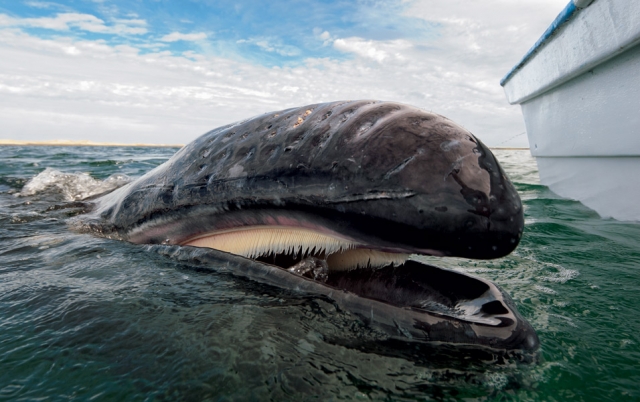
Every year, the residents and tourists of Baja California delight in the adventure of Whale Watching, a true tourist highlight sparked by the whales. It is a fantastic opportunity for marine biologists and nature lovers. Everyone is invited to the spectacle when these mammals arrive here.
Characteristics and Migration
The great marine mammal, Eschrichtius robustus, or more commonly known as the grey whale, is a toothless animal measuring between 12 and 16 metres in length and weighing between 20 and 35 tonnes. It has lungs and blowholes on the top of its head for breathing.
It maintains a temperature similar to that of humans, at 36° to 37°C, thanks to the fat that forms a thick layer under its skin. At birth, it is dark grey in colour but lightens over the years due to countless organisms that attach to its skin and leave white scars when they detach.

To feed, it uses keratin plates (similar to those found in human nails and hair) called baleen, which take on a whisker-like appearance. These are flexible and beige-white in colour, functioning to filter water and sand while retaining food. Its diet consists mainly of shrimp, plankton, algae, and amphipods. It is during the summer that grey whales focus on feeding in the depths of the Arctic and Bering Seas before their journey.

Every year, this extraordinary animal undertakes one of the longest migrations known to man in the animal kingdom. Indeed, the grey whale has a globetrotting lifestyle, spending half the year travelling and the other half feeding and reproducing.
They traverse the seas from the Arctic to Baja California and then to the Northern Hemisphere seas and back in just 6 months. This totals 16,000 kilometres over 183 days at a steady speed of 7 kilometres per hour, capable of swimming for 20 hours straight without rest.

From the Arctic, their long journey south towards the coasts of Mexico begins in early October.
Why do whales come to the Sea of Cortez?
Every year between November and March, grey whales make a strategic stop in the warm waters of the Sea of Cortez. For them, this destination serves as a natural sanctuary where they can be seen playing, reproducing, or giving birth to their calves.

Females mate every two years because a calf requires 13 months of gestation. They prefer depths of 3.5 to 15 metres to give birth in calm, temperate waters. Records confirm that one or two females assist a third to ensure the birth, pushing the calf to the surface to breathe.
Afterwards, the calf nurses on mother's milk for approximately 11 months, remaining inseparable from its mother until it grows strong enough to survive without her.
Whale Watching Tourism

Thanks to this species' lifecycle journey, they can be observed annually during their season at various points in Baja California. You can witness one of the planet's greatest natural spectacles by experiencing grey whale sightings. Truly, it is an unparalleled event that remains etched among visitors' fondest memories without a doubt. The main locations to observe this unique event are:
- Guerrero Negro,
- Magdalena Bay,
- Scammon's Lagoon, a protected area,
- San Ignacio Lagoon.
Fortunately, the government has already designated some of these zones as protected refuges for whales and calves. However, the hunting of these animals worldwide continues to earn them the unfortunate title of endangered species.

For this reason, it is important to support organisations and tourism companies that promote the care and conservation of the Baja California and Sea of Cortez ecosystem, as well as those providing tourism services in compliance with the regulations of SERMARNAT.
















